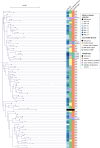A One Health investigation of Salmonella enterica serovar Wangata in north-eastern New South Wales, Australia, 2016-2017
- PMID: 30869062
- PMCID: PMC6518825
- DOI: 10.1017/S0950268819000475
A One Health investigation of Salmonella enterica serovar Wangata in north-eastern New South Wales, Australia, 2016-2017
Abstract
Salmonella enterica serovar Wangata (S. Wangata) is an important cause of endemic salmonellosis in Australia, with human infections occurring from undefined sources. This investigation sought to examine possible environmental and zoonotic sources for human infections with S. Wangata in north-eastern New South Wales (NSW), Australia. The investigation adopted a One Health approach and was comprised of three complimentary components: a case-control study examining human risk factors; environmental and animal sampling; and genomic analysis of human, animal and environmental isolates. Forty-eight human S. Wangata cases were interviewed during a 6-month period from November 2016 to April 2017, together with 55 Salmonella Typhimurium (S. Typhimurium) controls and 130 neighbourhood controls. Indirect contact with bats/flying foxes (S. Typhimurium controls (adjusted odds ratio (aOR) 2.63, 95% confidence interval (CI) 1.06-6.48)) (neighbourhood controls (aOR 8.33, 95% CI 2.58-26.83)), wild frogs (aOR 3.65, 95% CI 1.32-10.07) and wild birds (aOR 6.93, 95% CI 2.29-21.00) were statistically associated with illness in multivariable analyses. S. Wangata was detected in dog faeces, wildlife scats and a compost specimen collected from the outdoor environments of cases' residences. In addition, S. Wangata was detected in the faeces of wild birds and sea turtles in the investigation area. Genomic analysis revealed that S. Wangata isolates were relatively clonal. Our findings suggest that S. Wangata is present in the environment and may have a reservoir in wildlife populations in north-eastern NSW. Further investigation is required to better understand the occurrence of Salmonella in wildlife groups and to identify possible transmission pathways for human infections.
Keywords: One Health; outbreaks; salmonellosis; whole genome sequencing; zoonoses.
Conflict of interest statement
None.
Figures

Similar articles
-
Genomic characterisation of Salmonella enterica serovar Wangata isolates obtained from different sources reveals low genomic diversity.PLoS One. 2020 Feb 28;15(2):e0229697. doi: 10.1371/journal.pone.0229697. eCollection 2020. PLoS One. 2020. PMID: 32109266 Free PMC article.
-
Diversity of Salmonella serotypes from humans, food, domestic animals and wildlife in New South Wales, Australia.BMC Infect Dis. 2018 Dec 5;18(1):623. doi: 10.1186/s12879-018-3563-1. BMC Infect Dis. 2018. PMID: 30518339 Free PMC article.
-
Occurrence of Salmonella enterica in grey-headed flying foxes from New South Wales.Aust Vet J. 2021 Dec;99(12):517-521. doi: 10.1111/avj.13116. Epub 2021 Sep 6. Aust Vet J. 2021. PMID: 34490611
-
Animal contact as a source of human non-typhoidal salmonellosis.Vet Res. 2011 Feb 14;42(1):34. doi: 10.1186/1297-9716-42-34. Vet Res. 2011. PMID: 21324103 Free PMC article. Review.
-
Tackling salmonellosis: A comprehensive exploration of risks factors, impacts, and solutions.Open Vet J. 2024 Jun;14(6):1313-1329. doi: 10.5455/OVJ.2024.v14.i6.1. Epub 2024 Jun 30. Open Vet J. 2024. PMID: 39055762 Free PMC article. Review.
Cited by
-
Application of a Quantitative Real-Time PCR Assay for Early Detection of Salmonella enterica Serovar Enteritidis on Poultry Farms During an Outbreak in New South Wales, Australia (2018-2020).Transbound Emerg Dis. 2025 Jun 4;2025:9937941. doi: 10.1155/tbed/9937941. eCollection 2025. Transbound Emerg Dis. 2025. PMID: 40503217 Free PMC article.
-
Source attribution of salmonellosis by time and geography in New South Wales, Australia.BMC Infect Dis. 2022 Jan 4;22(1):14. doi: 10.1186/s12879-021-06950-7. BMC Infect Dis. 2022. PMID: 34983395 Free PMC article.
-
Genomic characterisation of Salmonella enterica serovar Wangata isolates obtained from different sources reveals low genomic diversity.PLoS One. 2020 Feb 28;15(2):e0229697. doi: 10.1371/journal.pone.0229697. eCollection 2020. PLoS One. 2020. PMID: 32109266 Free PMC article.
-
Divergent geography of Salmonella Wangata and Salmonella Typhimurium epidemiology in New South Wales, Australia.One Health. 2019 Apr 9;7:100092. doi: 10.1016/j.onehlt.2019.100092. eCollection 2019 Jun. One Health. 2019. PMID: 31016222 Free PMC article.
-
Beliefs, Attitudes and Self-Efficacy of Australian Veterinary Students Regarding One Health and Zoonosis Management.Animals (Basel). 2019 Aug 10;9(8):544. doi: 10.3390/ani9080544. Animals (Basel). 2019. PMID: 31405166 Free PMC article.
References
-
- Grimont PAD and Weill F-X (2007) Antigenic formulae of the Salmonella serovars: 9th edition, WHO Collaborating Centre for Reference and Research on Salmonella Available at https://www.pasteur.fr/sites/default/files/veng_0.pdf, (Accessed 2 July 2017).
-
- Vally H et al. (2014) Proportion of illness acquired by foodborne transmission for nine enteric pathogens in Australia: an expert elicitation. Foodborne Pathogens and Disease 11, 727–733. - PubMed
-
- Murray CJ (1991) Salmonellae in the environment. Revue Scientifique Et Technique 10, 765–785. - PubMed
Publication types
MeSH terms
LinkOut - more resources
Full Text Sources
Medical
Miscellaneous

